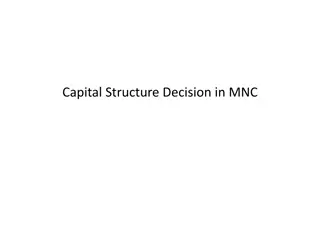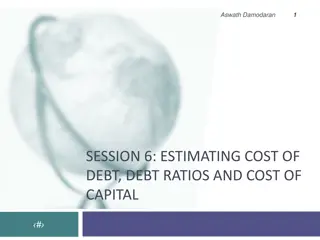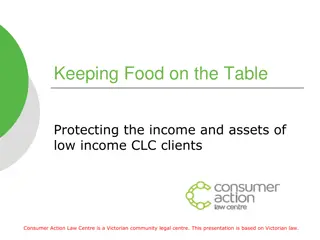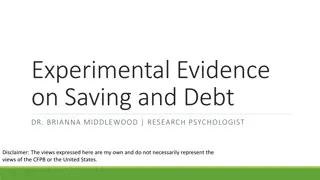Understanding Debt Capital in Chapter 8 of Accounting for Managers
Explore the concept of debt capital and liabilities in Chapter 8 of Accounting for Managers by Professor Zhou Ning from Beihang University. Learn about the nature of liabilities, legal obligations, contingencies, and levels of likelihood in financial reporting. Discover how to differentiate between accounting liabilities and non-accounting obligations.
Download Presentation

Please find below an Image/Link to download the presentation.
The content on the website is provided AS IS for your information and personal use only. It may not be sold, licensed, or shared on other websites without obtaining consent from the author. Download presentation by click this link. If you encounter any issues during the download, it is possible that the publisher has removed the file from their server.
E N D
Presentation Transcript
Accounting For Managers Professor ZHOU Ning SCHOOL OF ECONOMICS AND MANAGEMENT BEIHANG UNIVERSITY zning80@buaa.edu.cn
Chapter 8 Sources of Capital: Debt
The objectives of chapter 8 The nature of liabilities Debt capital Analysis of capital structure 8-3
Liability Definition Obligation to an outside party. Arises from a transaction or an event that has already happened. Estimated warranty is an example of a liability that is not legally enforceable. 8-4
Legal obligations that are not accounting liabilities Executory contracts = contracts in which neither party has yet performed. Sales contract for future delivery of certain goods to the buyer. Contract to pay a baseball player $1 million per year for five years. A contract to provide legal services next year. 8-5
Are these liabilities? Purchase contract for future delivery of certain goods from the seller. A baseball club signs a contract to pay a certain player $1m per year for five years. The player works in the year in which the contract is signed. A law firm signs a contract in which it agree to provide legal services next year. Receive $50,000 retainer for legal services to be performed on an as-needed basis next year. Seller of a house receives $10,000 as a non- refundable deposit. Yes! No! Yes! No! No! Yes! 8-6
Contingency Uncertainty as to possible gain or loss that will ultimately be resolved by some future event. Gain contingencies usually not reported (conservatism). Loss contingencies Potential future payment from existing conditions. Uncertainty about amount. Outcome will be resolved by future events. 8-7
Levels of likelihood/GAAP Probable: likely to occur Reasonably estimated/Accrue. Not reasonably estimated/Disclose Reasonably possible: more than remote but less than likely: Disclose Remote: slight chance of occurring No accrual No disclosure. 8-8
Contingent liabilities on FS? Expect to be sued due to damage caused by our product. Outcome unknown. Disclose Pending lawsuit. Probable loss from $100K to $2KK. (Reasonably possible?) Liability $100K Lawsuit pending. Remote chance of loss. No L&D Sales during year were $1KK. Products warranted for 1 year. Historically, Liability $30,000 Warranty costs are 3% of sales. No L&D Bad debts are 2% of sales. A loss--Expense 8-9
Liabilities as a Sources of Funds Debt capital. Company pays for use of capital that others furnish. Equity capital. Obtained from shareholders. Direct contribution (paid-in capital). Indirect contribution (retained earnings). 8-10
Debt Capital Debt instruments. Term loans. Repayable according to a specified schedule usually with equal installments of principal and interest. Bond. Certificate promising to pay its holder: Specified sum of money at a stated date and Interest at a stated rate until maturity. Price quoted as % of face, e.g., 98 or 102. 8-11
Bonds Interest rate usually constant through life, could be variable (variable-rate bonds). Bond indenture Contains covenants which are requirements such as maintaining certain minimum financial ratios. If covenants are not met, then loan is technically in default; creditors can demand immediate payment or changes to be made by management. Mortgage bond is secured by pledged assets. Debenture bond is not secured by specific assets. 8-12
Bond redemption Payment of principal at maturity of bonds. Thus, cancellation (under some circumstances earlier than maturity). Sinking fund bonds. Require setting aside cash/investments to be used to redeem bonds at maturity or at regular intervals. Sinking funds are controlled by a trustee (e.g., a bank). Shown on BS as Investments or other assets. 8-13
Other bond features Serial. Redeemed in installments. Redemption date specified on bond itself. Convertible. Bondholder has the right to exchange bond for specified # of shares of stock. Subordinated. Claims are inferior to claims of general or secured creditors but take precedence over claims of shareholders. Zero coupon bonds. No interest is paid. Issued at deep discount. Callable. Call the bonds for redemption before the maturity date. 8-14
Terms Par value = face value = principal value = maturity value. Coupon rate = stated interest rate. Interest payments = face value * stated interest rate. Issuance costs: investment banking, accounting, legal and printing fees. Deferred charges amortized over life of bonds using straight-line (SL) method. 8-15
Analysis of capital structure Leverage = measure of soundness of company s financial position. 8-16
Analysis of capital structure $millions % $1,600 1,800 3,600 $7,000 Current liabilities Long-term liabilities Shareholders equity Total liabilities and owners equity 23% 26% 51% 100% Debt equity ratio = $3,400/$3,600=94% Debt capitalization ratio=$1,800/($1,800+$3,600)=33% Times interest earned = $1,000/$200=5.0 times 8-17
Discussion Questions What has more risk: debt or equity capital? From company point of view? From investor point of view? Why do we use the term leverage for the debt-to-equity ratio? 8-18
Summary of Chapter 8 The nature of liabilities Debt capital Analysis of capital structure 8-19
Assignments of Chapter 8 Case 8-2 8-20
Thank you 8-21























